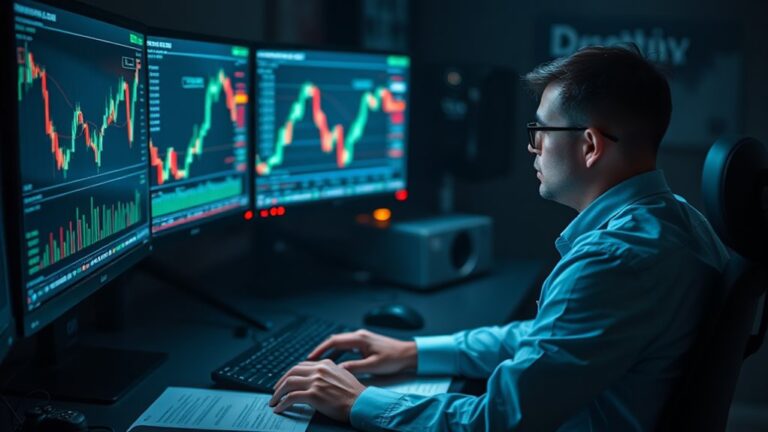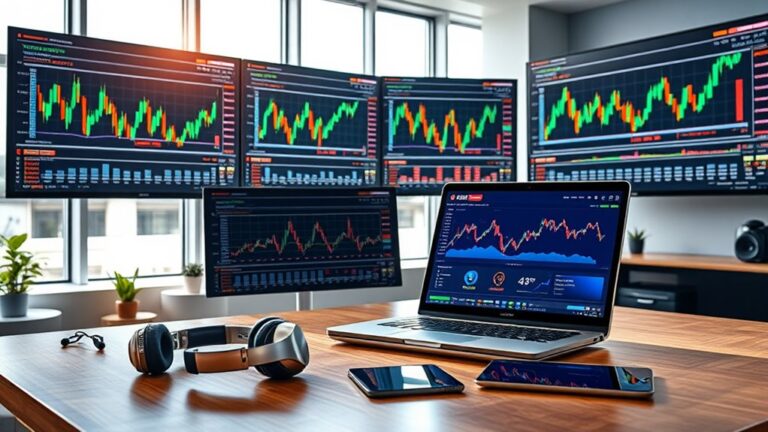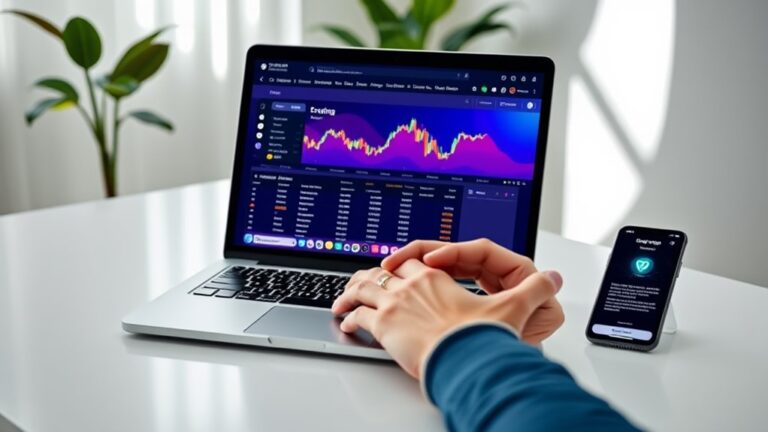
Understanding Trading Volume and Liquidity: The Essential Guide to Better Crypto Trading
Trading volume in cryptocurrency reveals the total amount of coins exchanged over a specified period, commonly a day, reflecting market activity and liquidity. High trading volumes indicate strong market interest, contributing to stable prices and reduced transaction cost discrepancies. This liquidity facilitates easier asset transactions, ensuring more predictable and less volatile market conditions. Understanding the dynamics of volume and liquidity can be instrumental in developing effective trading strategies, potentially leading to more successful investment outcomes. Further exploration into these concepts could enhance your trading acumen.
Key Takeaways
- Trading volume measures coins exchanged, providing insights into market interest and trading patterns.
- High trading volumes enhance liquidity, allowing easier and more stable trades.
- Volume fluctuations can signify trend strength or reversals in market sentiment.
- Utilize tools like OBV and MFI for deeper analysis of volume and price correlations.
- Assessing volume helps in identifying genuine market moves versus manipulative trading practices.
The Basics of Trading Volume in the Crypto Market

In the dynamic world of cryptocurrency, trading volume is a critical metric that represents the total number of coins that exchange hands within a specific timeframe, usually over 24 hours. This volume is an essential indicator of market activity and traders' interest, calculated by summing up all cryptocurrencies exchanged during the trades. High trading volumes usually suggest a strong interest in the market, reflecting active buying and selling. For reporting, volume figures are often expressed in standard currencies such as USD or in Bitcoin (BTC) equivalents. Such measurements not only assess the health of market transactions but also serve as a benchmark for the liquidity and vibrancy of a cryptocurrency market. Properly analyzing trading volumes can significantly aid in understanding not only market liquidity but also the potential direction the market might take next.
How Trading Volume Influences Liquidity

When examining the relationship between trading volume and liquidity in the financial markets, it's clear that high trading volume is often indicative of strong liquidity. High trading activity signals the presence of many buyers and sellers, enhancing market efficiency and stabilizing prices through the swift absorption of large orders. Reduced slippage occurs because price estimates closely match the executed transaction costs, creating an environment resistant to price manipulation. This dynamic underpins the foundational structures that constitute a reliable, efficient trading environment in the financial markets, particularly within the domain of cryptocurrencies. In the context of decentralized exchanges, enhanced privacy and control are key advantages that attract increased trading volumes, further bolstering liquidity and market efficiency.
Indicators of Market Sentiment Through Trading Volume Analysis
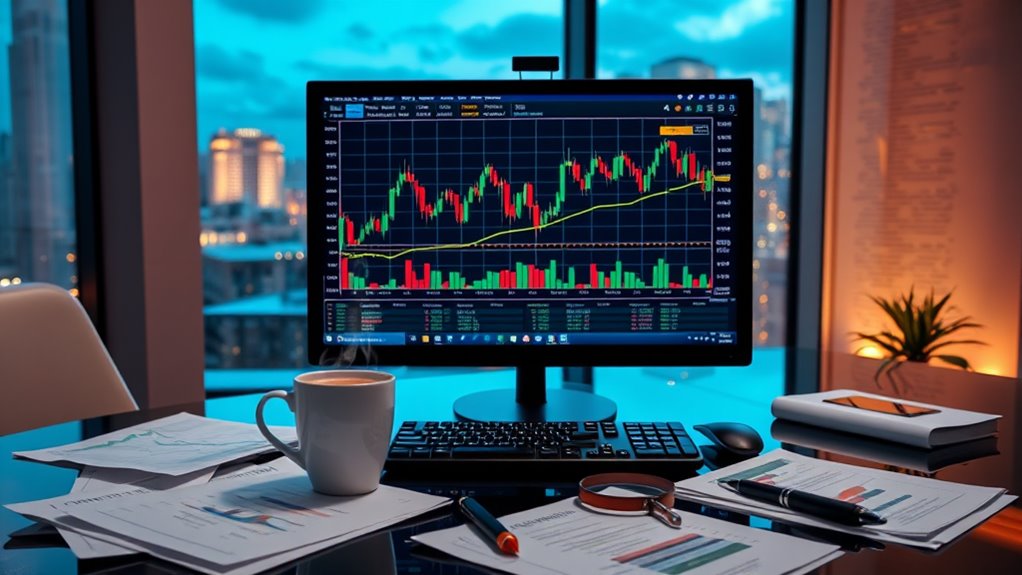
Analyzing trading volume provides key insights into market sentiment, helping traders distinguish between bullish and bearish conditions. A surge in volume often reflects strong trader conviction, potentially signaling the continuation of a current trend. Conversely, diminished volume can suggest a lack of participant agreement or an impending reversal in market direction. Additionally, understanding the nuances of market making and liquidity provision can significantly enhance a trader's ability to read market conditions more accurately.
Volume Trends Reflect Sentiment
Volume trends serve as a barometer of market sentiment, revealing the collective mood of investors through their trading activities. These trends show whether the market strength is increasing or waning by reflecting the levels of participation and interest. High trading volume often signals key movements in price due to either accumulation or distribution of assets, suggesting strong sentiment. Conversely, low volume may indicate a lack of investor interest or confidence, potentially leading to price stagnation. Additionally, understanding these volume patterns can assist in the development of effective trading strategies, helping traders make informed decisions based on observed market behaviors.
Distinguishing Bullish vs. Bearish
Building on the understanding that volume trends reflect sentiment, it is further possible to distinguish between bullish and bearish market conditions by analyzing how trading volumes relate to price movements. Significant indicators such as On-Balance Volume (OBV) and Volume-weighted Average Price (VWAP) allow for a nuanced understanding of market dynamics. Here's a comparative look at the primary volume-based indicators:
| Sentiment Type | Indicator | What It Suggests |
|---|---|---|
| Bullish | High OBV | Increased buying pressure |
| Bullish | Rising VWAP | Strong buying interest |
| Bearish | Low OBV | Increased selling pressure |
| Bearish | Falling VWAP | Dominance of sellers |
This table illustrates how specific volume metrics can guide traders in recognizing market conditions adeptly. Embracing these insights alongside strategies such as risk management can significantly enhance trading effectiveness in the volatile crypto market.
The Relationship Between Trading Volume and Price Movements
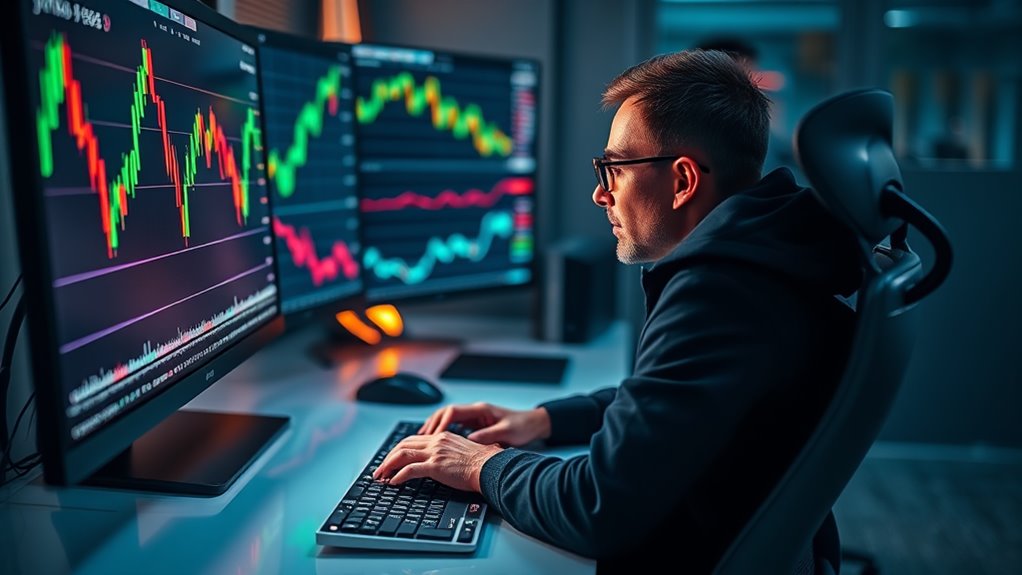
When examining the impact of trading volume on price movements in cryptocurrencies, it becomes clear that volume is a fundamental metric of market dynamics. High trading volumes indicate strong market participation, serving as a vital indicator of liquidity and reflecting the intensity of buying or selling interest.
For instance, a substantial increase in volume accompanying a price rise shows strong buyer engagement, suggesting a possible continuation of the uptrend. Conversely, an increase in volume with a price decrease can indicate panic selling or strong selling pressure.
Additionally, sudden spikes in volume can precede significant price adjustments, providing early signals for potential market shifts. Understanding these patterns helps traders and investors make more informed decisions.
To further enhance the accuracy of predicting market movements, traders can integrate moving averages with volume analysis, emphasizing the importance of combining various technical indicators for a more robust trading strategy.
Technical Tools for Analyzing Trading Volume in Cryptocurrency
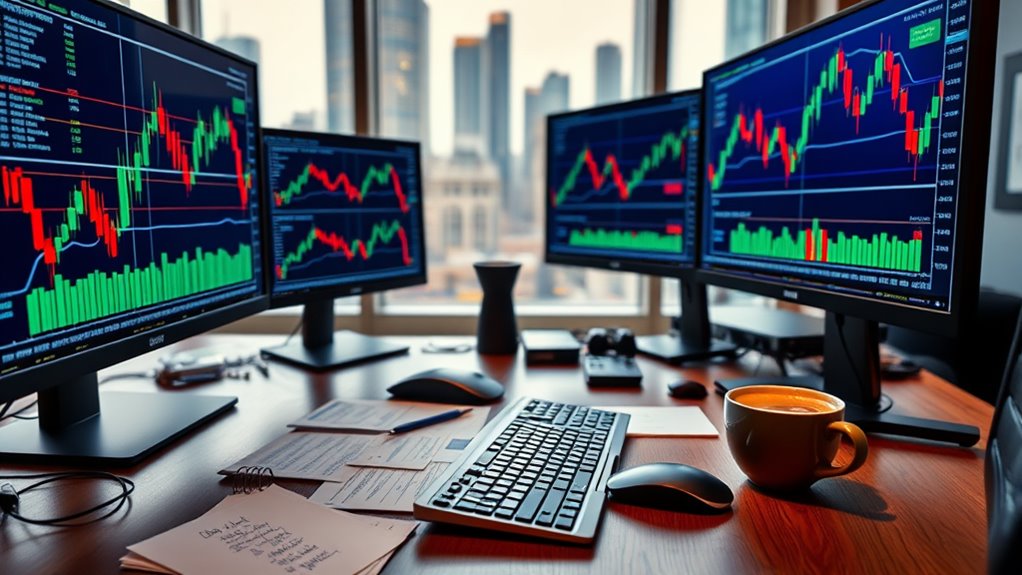
To effectively analyze trading volume in the cryptocurrency market, traders and investors rely on a variety of technical tools.
Exploring cryptocurrency market dynamics through diverse technical tools enhances trading volume analysis for investors.
These tools are essential for interpreting market signals and guiding trading decisions. Here is a selection of key tools:
- On Balance Volume (OBV): This indicator aggregates buy and sell volumes to predict price movements, providing insights into market pressure.
- Money Flow Index (MFI): Combines price and volume to determine the inflow or outflow of money into a cryptocurrency, often indicating potential reversals or trend continuation.
- Volume Profile: Highlights significant trading activity at specific price levels, helping identify areas of support and resistance.
- Relative Volume: Compares current trading volumes against historical averages, spotlighting unusual market activity that could precede price changes.
The Importance of Liquidity in Cryptocurrency Exchanges

In cryptocurrency exchanges, liquidity reflects how quickly and easily assets can be bought or sold without causing significant price changes. This liquidity is essential for enhancing trade efficiency, allowing transactions to be completed swiftly with minimal impact on market prices. Additionally, trading volume plays an important role in sustaining liquidity, as it indicates the level of activity and the ease of entering or exiting positions in the market. AMMs offer a unique approach by automating liquidity provision through the use of smart contracts, which keeps markets fluid and reduces transaction delays.
Defining Market Liquidity
Market liquidity is an essential concept in financial markets, particularly relevant in the fast-paced world of cryptocurrency exchanges. It defines the ease with which assets can be bought or sold at stable prices and is important for operational efficiency.
Elements contributing to market liquidity include:
- Active Participation: Presence of numerous buyers and sellers that helps in maintaining fluid market conditions.
- Bid-Ask Spread: Narrower spreads indicate higher liquidity, making it easier to execute transactions without large price impacts.
- Trade Execution Speed: Faster transactions are an indicator of good liquidity, reflecting a market's ability to quickly handle buy and sell orders.
- Market Stability: High liquidity contributes to less price volatility, ensuring more predictable and stable market conditions.
In the decentralized finance sector, liquidity pools play a vital role by ensuring continuous liquidity for various trading platforms, which facilitates the efficient exchange of different cryptocurrencies.
Impacts on Trade Efficiency
Why does liquidity matter in the domain of cryptocurrency exchanges?
Liquidity is vital because it directly affects trade efficiency. Highly liquid markets enable traders to execute transactions swiftly and at desired market prices. This allows for minimal slippage, where the actual transaction price closely aligns with the expected price, reducing transaction costs for participants.
Additionally, exchanges that maintain high liquidity are capable of handling larger trade volumes without significant disruptions. This not only supports a dynamic trading environment with more participants but also enhances the overall trading experience.
Effective liquidity guarantees that both entry and exit from market positions are facilitated with ease, promoting a more robust and efficient trading landscape.
Choosing a platform with robust security features is also crucial, as this ensures that trades are not only efficient but also secure from potential threats.
Volume's Role in Liquidity
Volume plays a pivotal role in determining the liquidity of cryptocurrency exchanges. A high volume of trade signifies vibrant market activity, attracting more participants and reducing the spread between buy and sell prices.
This dynamic interplay enhances the overall trading environment by ensuring fluidity and price stability which are essential for both novice and experienced traders. Here's how volume influences liquidity:
- Market Participation: Increased trading volume symbolizes higher participant engagement.
- Price Stability: Consistent volume contributes to less price fluctuation.
- Liquidity Providers: More volume attracts liquidity providers like market makers.
- Investor Confidence: Sustained high volumes build trust in the market's robustness and reliability.
Understanding these factors aids traders in making informed decisions within the cryptocurrency markets. For those new to the space, setting up an account on a reputable platform is an essential first step towards engaging in cryptomarket trading.
Strategies to Leverage High Trading Volume for Profitable Trading
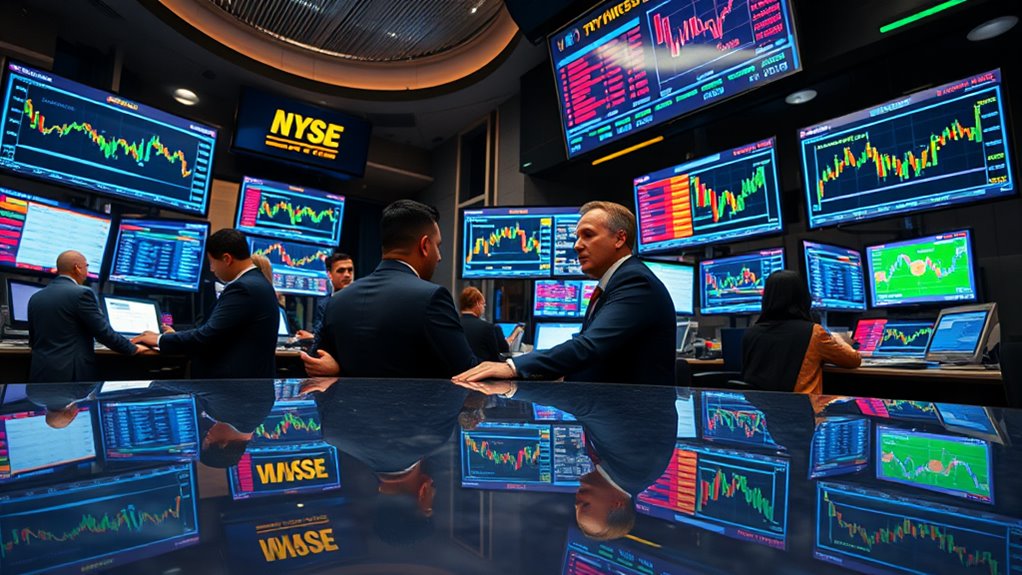
Many traders are leveraging high trading volume to enhance the profitability of their strategies, recognizing that the intensity of trading activity can markedly pinpoint market opportunities. High trading volumes signify strong market interest and are essential in executing strategies like Momentum Trading and Scalping, where quick entry and exit are vital.
| Strategy | Description | Benefit of High Volume |
|---|---|---|
| Momentum Trading | Capitalizes on market momentum | Confirms trend strength |
| Scalping | Executes quick, frequent trades | Enables frequent trade execution |
| Arbitrage | Exploits price differences across markets | Faster execution improves profitability |
| Market Making | Profits from bid-ask spreads | Guarantees liquidity, minimizing spread costs |
| Statistical Arbitrage | Uses models to identify price discrepancies | Volume increases model accuracy |
These strategies optimize trading outcomes by utilizing volume as a signal for executing trades more effectively and efficiently.
Addressing Challenges and Pitfalls in Volume Interpretation

In the field of volume interpretation within trading markets, accurately identifying volume manipulation stands as a critical challenge that analysts face.
It is imperative for those involved to verify the reliability and source of data to guarantee that the trading volume information reflects true market activity and is not distorted.
This allows traders and investors to make more informed decisions, avoiding potential pitfalls that arise from misinterpreted or manipulated volume data.
Identifying Volume Manipulation
How can traders discern genuine volume fluctuations from those manipulated by deceitful tactics? Recognizing the signs of volume manipulation is essential for traders who wish to engage in ethical and effective market participation.
Below are strategies to identify such discrepancies:
- Wash Trading Identification: Look for repetitive buying and selling by a single party aimed at inflating volume figures.
- Analyzing Pump-and-Dump Patterns: Observe unnatural price spikes followed by sharp declines, which may indicate manipulative hype.
- Transparency Checks: Assess the exchange's transparency regarding trade data, which helps in spotting hidden manipulative activities.
- Volume and Price Correlation Analysis: Compare volume spikes with price movements to determine if the volume supports the price change or is artificially created.
Verifying Data Sources
Verifying data sources is pivotal when analyzing trading volume and liquidity to guarantee accuracy and reliability in the marketplace. When dealing with cryptocurrency markets, sources such as institutional data providers and real-time updates provide a solid base for interpretation. Thorough and regulatory-compliant metrics are essential to filter out noise and prevent the risks associated with wash trading and inconsistent reporting.
| Source Feature | Description |
|---|---|
| Institutional Data | Includes market cap, volume, liquidity |
| Real-time Updates | Essential for current market dynamics |
| Blockchain Insights | Tracks transaction counts, flows |
Consolidating data from various trusted sources, employing rigorous surveillance techniques, and utilizing tools like APIs enhance the quality and trustworthiness of the information, facilitating more informed decisions in the volatile crypto market.
Integrating Volume With Other Technical Indicators for Enhanced Insights
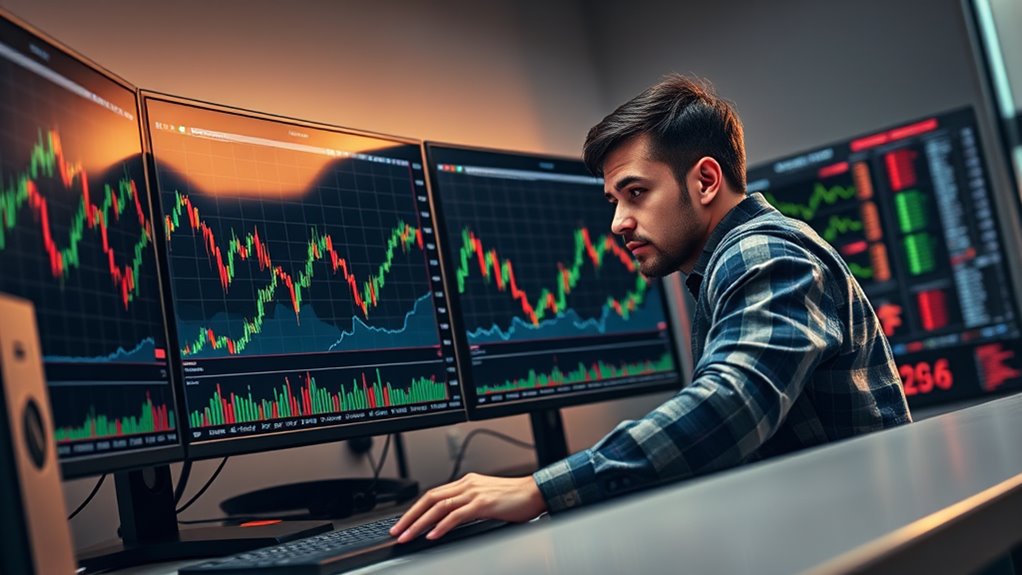
When traders integrate volume with other technical indicators, they gain enhanced insights into market dynamics. This deeper analysis enables a more informed approach to trading, especially in the volatile world of cryptocurrencies.
Key methods include:
Explore crucial methods integrating volume with indicators for deeper market insights and informed trading strategies.
- Trend Confirmation: Combining volume with moving averages or ADX helps confirm the strength and sustainability of a trend.
- Reversal Signals: Spikes in volume when prices diverge from trends (Volume-Price Divergences) often flag potential reversals, providing critical entry or exit points.
- Breakout Validation: High volume levels during a price breakout from Bollinger Bands or trendlines confirm robust market participation and the likelihood of trend continuation.
- Momentum Assessment: Analyzing volume alongside oscillators like RSI or MACD enhances the reliability of momentum signals.
Future Trends in Trading Volume and Market Analysis Techniques

Building on the understanding of how volume interacts with technical indicators in informing trading strategies, it is equally significant to explore emerging trends in trading volume and market analysis techniques.
The growing interest from institutional investors, spurred by products like spot ETFs and supportive regulatory environments in regions like Singapore and Hong Kong, is reshaping demand dynamics.
Simultaneously, AI integration in trading is expanding with AI tokens, now valued over $39 billion, altering volume patterns.
Additionally, liquidity enhancement strategies through improved market participation and technological advancements are making trading smoother and more efficient.
Amid these developments, traders must adapt by incorporating volume analysis with emotional indicators, like fear and greed, to navigate the increasingly complex market landscape effectively.
Frequently Asked Questions
How Do Transaction Fees Impact Trading Volume Measurements?
Transaction fees influence trading volume by either deterring or encouraging trader activity. High fees may reduce the frequency of trades, whereas lower fees can increase trading volume by making frequent transactions more economically viable.
What Role Does Algorithmic Trading Play in Volume Discrepancies?
Like chess masters in a digital arena, algorithmic trading systems exploit volume discrepancies by executing rapid, unbiased decisions, thereby increasing liquidity and potentially manipulating volumes through practices like wash trading and pump-and-dump schemes.
How Do Holidays and Weekends Affect Crypto Trading Volume?
Holidays and weekends typically see a decrease in crypto trading volume as fewer traders are active, leading to less liquidity and increased volatility. This change often results in greater price fluctuations and potential market manipulation.
What Measures Can Traders Take Against Volume Spoofing?
To combat volume spoofing, traders can utilize volume analysis to detect anomalies, integrate machine learning for enhanced detection, trade in high-volume markets, and stay informed about regulatory measures targeting manipulative trading practices.
How Do Geopolitical Events Influence Liquidity and Volume Trends?
Geopolitical events often disrupt market stability, leading to altered liquidity and trading volume in cryptocurrencies. Investors may shift towards stablecoins, increasing their liquidity while traditionally volatile assets might see fragmented liquidity and heightened trading volume.
Conclusion
In summary, understanding trading volume and liquidity is vital for effective cryptocurrency trading. Properly analyzing trading volume provides insights into market sentiment and potential price movements, enhancing trading strategies. By integrating volume with other technical indicators, traders can achieve richer, more accurate market analyses. As technology evolves, so will volume analysis techniques, making adaptability and continuous learning essential components for traders aiming to stay ahead in the rapidly changing crypto market.

